Userguiding vs Walkme: Which Tool is Best for Collecting Customer Feedback?
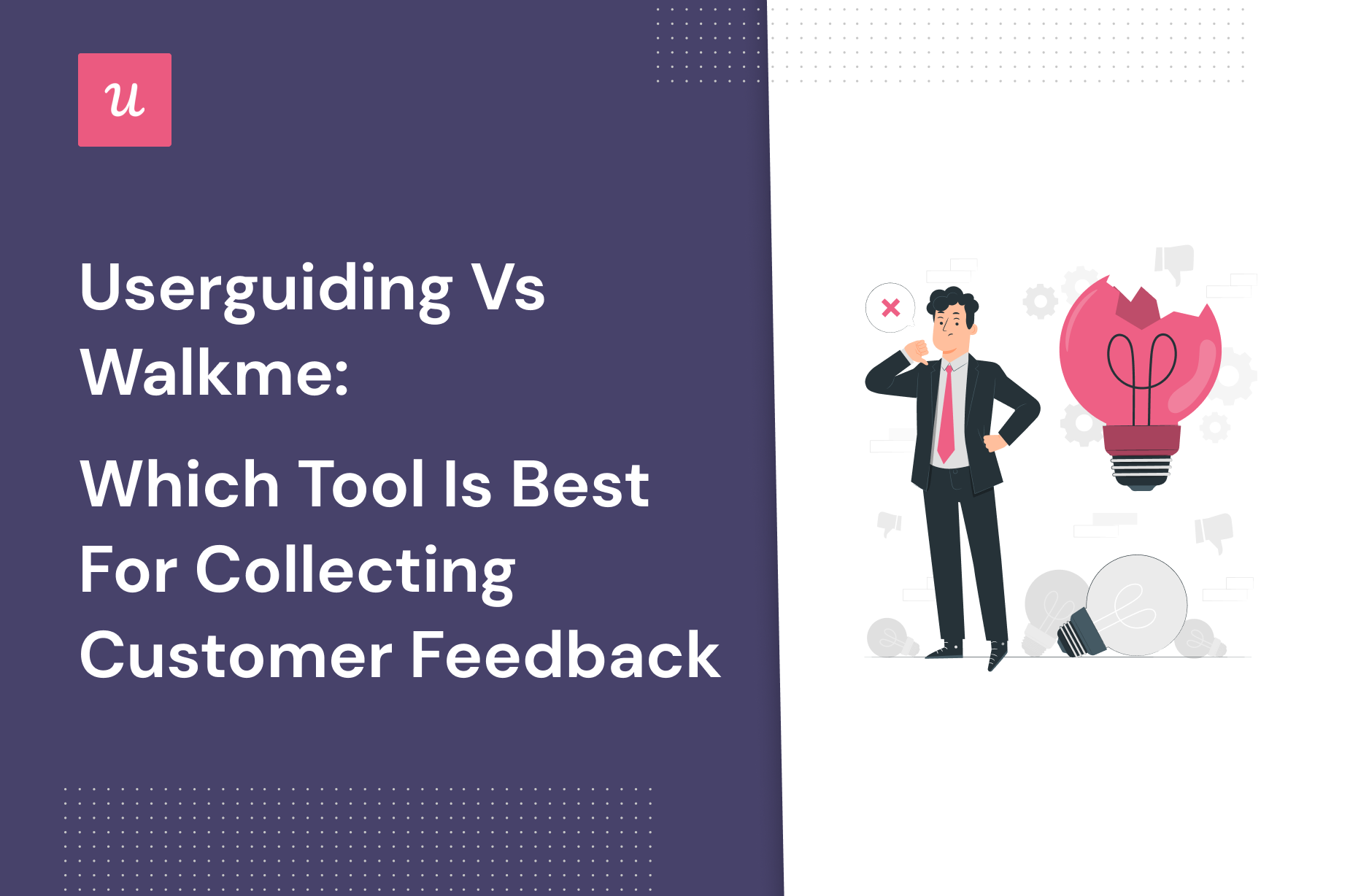
Is Userguiding or Walkme the best tool for customer feedback? And is there a better in-app onboarding software that would better fit your needs?
With so many alternatives on review sites, it’s a bit tricky to really choose one.
You need to consider your priorities and what functionality you’ll need from the tool to get the job done. Then there’s also the price that needs to match your budget. Right?
In this post, we’ll discuss exactly that – what the perfect tool for customer feedback should deliver and which will be the best choice for your company’s needs.
Let’s dive in!
TL;DR
- Collecting customer feedback helps you understand your users’ needs through real-time insights that inform future feature and product decisions.
- Customer feedback tools facilitate feedback collection at scale without disrupting the user experience or needing help from your dev team to design, launch and analyze the data.
- A good customer feedback tool should have a certain set of features: 1) the ability to create different forms of micro surveys, such as NPS, CSAT, CES, and PMF to collect contextual feedback; 2) the ability to customize the surveys to match your native UI; 3) Ability to segment the user and trigger the surveys by the different segments. 4) Ability to analyze the results – both quantitative and qualitative.
- Using product adoption tools like Userguiding or WalkMe gives you an advantage when it comes to collecting feedback as you can launch surveys directly in-app to the right user and collect more accurate responses.
- Walkme is an enterprise onboarding tool, mostly used for employee onboarding. Unlike Userguiding, Walkme offers a quite good customer feedback collection and analysis tool for SaaS – you can create different types of surveys such as NPS, CSAT, and CES and customize them with different question types such as free text, single selection, multiple selections, rating etc. Then, you can easily analyze the survey results and data in the “Insights” section.
- Userguiding has a built-in NPS survey feature that allows you to create NPS surveys fast. The downside of using UserGuiding for collecting user feedback is that you can’t tag NPS responses so you can identify trends between scores. You also can’t create long forms as they neither support it in their native interface nor have integrations with other 3-rd party tools to do the job.
- When it comes to pricing, Walkme, and Userguiding are at opposite extremes: starting at $99 per month, you can start collecting NPS feedback with Userguiding, a functionality that can cost $55,000 or more with WalkMe (their price is on-demand only)
- There’s a better alternative both in terms of money and value if neither Userguiding nor WalkMe is what you expected. Userpilot offers the best of both worlds – easy setup of the in-app customer feedback surveys, full customizability, and in-app analytics options, and yet – it’s perfectly affordable with plans starting at $249 per month!
- Userpilot’s new robust surveys offer a range of interactive in-app surveys featuring NPS, CSAT, CES, and PMF. You can fully customize the survey look and feel and set the trigger frequency and specific targeting. Then, you can analyze the scores, tag responses, and use the data to create specific user segments.
- Get a Userpilot demo and see it in action.
![]()
Looking for the best customer feedback tool? Search no more!

What is customer feedback?
Customer feedback is any information provided by customers about their experience with a product or service. By analyzing customer feedback, you can reveal their level of satisfaction and pinpoint areas for improvement.
Is customer feedback necessary?
Customer feedback is important if you want to truly serve your customers and come up with solutions that can solve their pain points.
Here is why customer feedback matters:
- Understand whether customers see value in your product and if it meets their needs
- Uncover weak spots of your product and bottlenecks that disturb the customer journey
- Make your customers voices heard and acknowledge them that they are important to you
- Collect real-time insights on the go as you’re introducing new features or product updates
Why do you need tools for customer feedback?
Wondering why you even need a customer feedback tool? There are several reasons why you may need one:
Collecting customer feedback should be a standard procedure for any product team.It should be consistent and gained across different stages of the customer journey so you can measure customer experience in different situations. This might be time-consuming but thanks to customer feedback tools, the process can be hassle-free and literally without any coding.
Here’s how customer feedback tools help.
- Create different forms of microsurveys, such as NPS, CSAT, CES, PMF to collect contextual feedback
- Customize the surveys so they are aligned with your brand and match the interface of your app
- Segment customers by their feedback so you can create personalized flows for them
- Conduct a user sentiment analysis to understand your customers better
Now you might ask yourself, how to choose the right customer feedback tool for your SaaS? This is what we will be discussing next.
Must-have features for customer feedback collection
Before deciding which customer feedback tool works best, you should understand what features any solid tool must provide.
Here’s what to look for before making a buying decision:
- Make sure the tool you choose supports multiple forms of microsurveys. The most important and popular ones for collecting customer feedback include the Net Promoter Score, Customer satisfaction score, Customer effort score, product-market fit survey, etc
- You should also get customization capabilities so that the surveys you create match your interface and don’t look odd. No tool branding is also preferable
- Feedback analytics and response monitoring are the next key features if you want to not only collect feedback but also analyze it and understand the intent behind your customers’ scores.
- Integration with 3rd party survey and analytics tools so you can enrich your surveys to make the most out of the customer feedback
There you have it. These are the basic features you should be looking for, but the tool you should go with must be dependent on your specific goals. You might need a tool that must cover all of these features but if you don’t need complex features, you should be completely ok with a tool with limited functionalities.
Userguiding for customer feedback
UserGuiding is a lower-cost, entry-level product adoption tool offering a range of features to help companies onboard new customers and boost product adoption.
UserGuiding excels at building simple onboarding experiences for users. It includes a no-code builder, segmentation options, and easily added UI patterns like hotspots, tooltips, and modals.
Although it also has some other goodies like a resource center and analytics, the meat of this product is its onboarding flow builder.
If all you’re looking for is a relatively easy way to build simple onboarding flows, this could be a great choice for you. However, people looking for more analytics, customization, or complex integrations should probably look elsewhere.
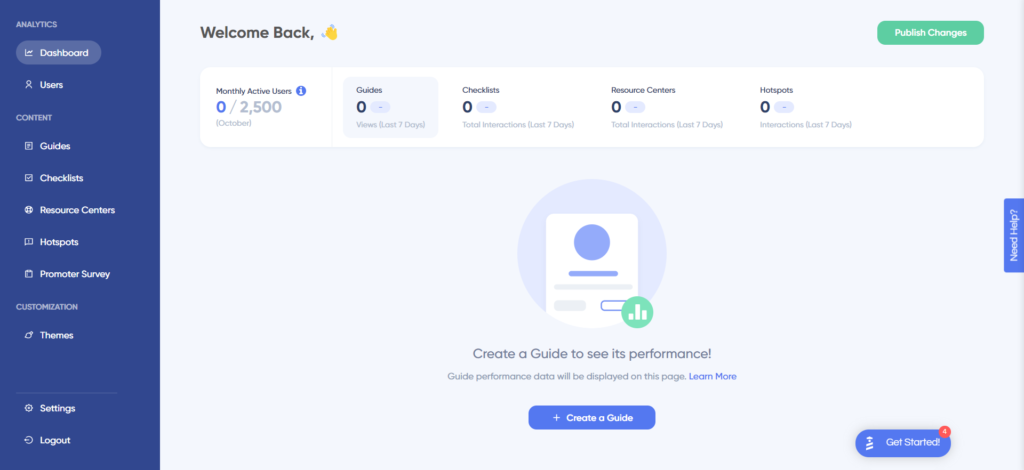
With UserGuiding, you can collect user sentiment data with NPS surveys and microsurveys even when using the Basic plan.
Here’s how you can collect user feedback with UserGuiding:
- Build NPS surveys without writing a single line of code.
- Adjust the thank you page and add a follow-up question to gather qualitative data and understand the reasons behind the scores.
- Customize the button texts, colors, and design to match your brand
- Set up custom audiences, segments, timing, and targeting rules to trigger the surveys
The downside of using UserGuiding for collecting user feedback is that you can’t tag NPS responses so you can identify trends between scores. You also can’t create long forms as they neither support it in their native interface nor have integrations with other 3-rd party tools to do the job.
Considering that, Userpilot undoubtedly offers you more value for money. You can build micro surveys, embed Typeform long surveys, collect and analyze NPS responses, and segment users based on scores and responses so you can trigger more personalized experiences. Get a Userpilot demo here!
Pros of Userguiding?
There are some advantages when it comes to choosing UserGuiding. Here are its pros:
- For small startups or independent businesses, the price is an attractive element to consider.
- A good variety of UI patterns to choose from when building flows and guides
- Unlike some of the more expensive options, you can choose to add a Resource Center (a bonus for self-service support).
- For a budget tool, UserGuiding still offers integrations with other applications, such as Mixpanel, Hubspot, Woopra, Slack, Webhook, etc.
Cons of Userguiding?
Though UserGuiding is a solid product many improvements are still needed. The cons of using UserGuiding include:
- There are many bugs and performance issues when using the tool. The UI is also fairly tricky to navigate.
- It has limited functionality, particularly on the basic plan. There you only have a small range of features available – all with the UserGuiding watermark/branding.
- Technical knowledge is required to get the maximum out of this product.
- Customization and design options for UI patterns aren’t the greatest.
What users say about Userguiding?
If you check the product review sites, most people like using UserGuiding.
Here are some reviews from real users:
Creating guides/checklists are easy to implement. It does not take a lot of time to make adjustments when you need to make changes.
You can go live with a simple guide or checklist within minutes. I was able to go live within a few days of getting started. – Administrator in Computer Software
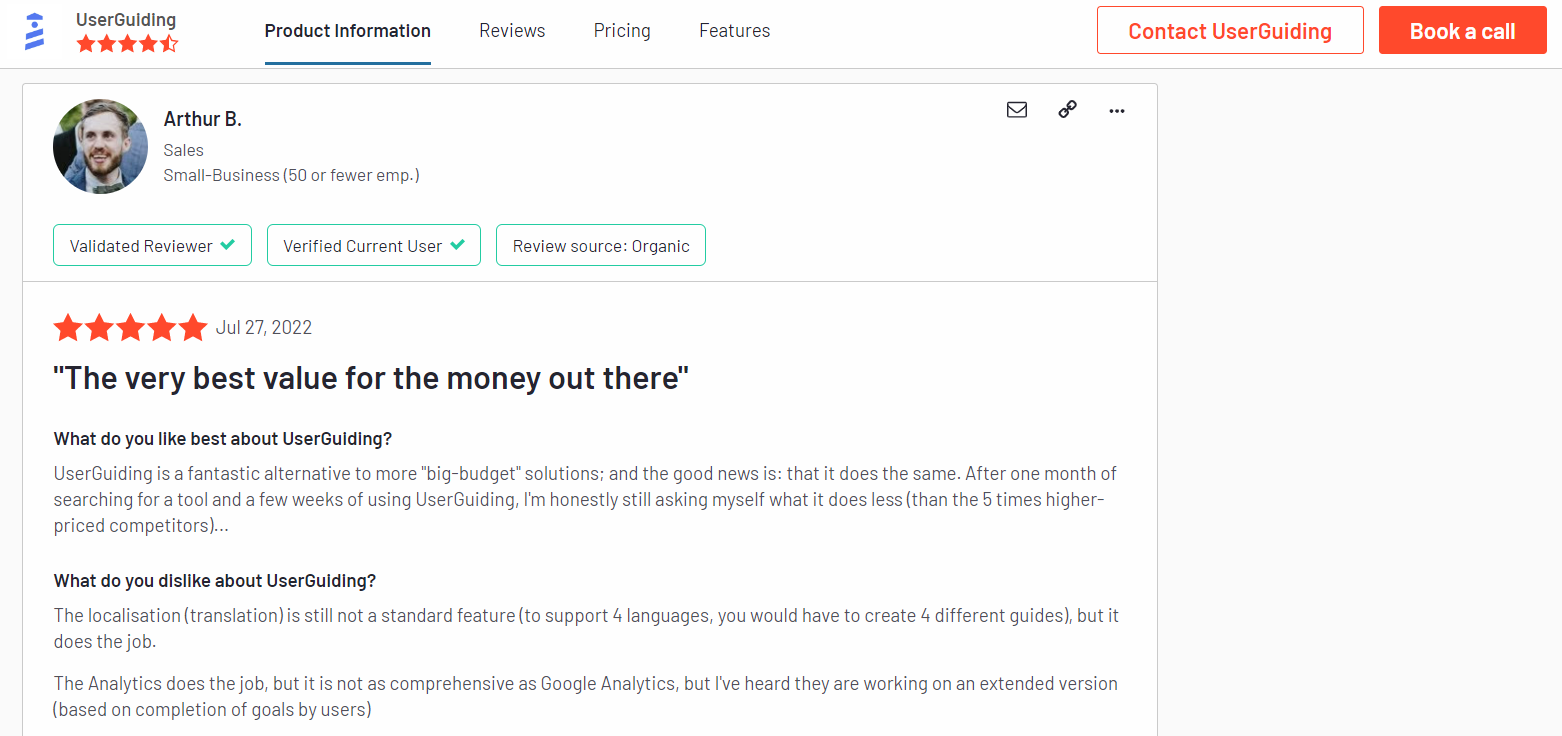
However, some people think there’s too much friction due to bugs. Let’s have a look at some negative reviews to see why users complain about:
It is a bit buggy, sometimes it lags or freezes.
And, some people think that there is still room for improvement:
The analytics felt a little elementary. Other than the Mixpanel integration, it wasn’t possible to analyze user data directly on the UserGuiding dashboard. There was an API we could use that required some set up, but this was something I expected to be baked into the product for sure.- Administrator in Computer Software
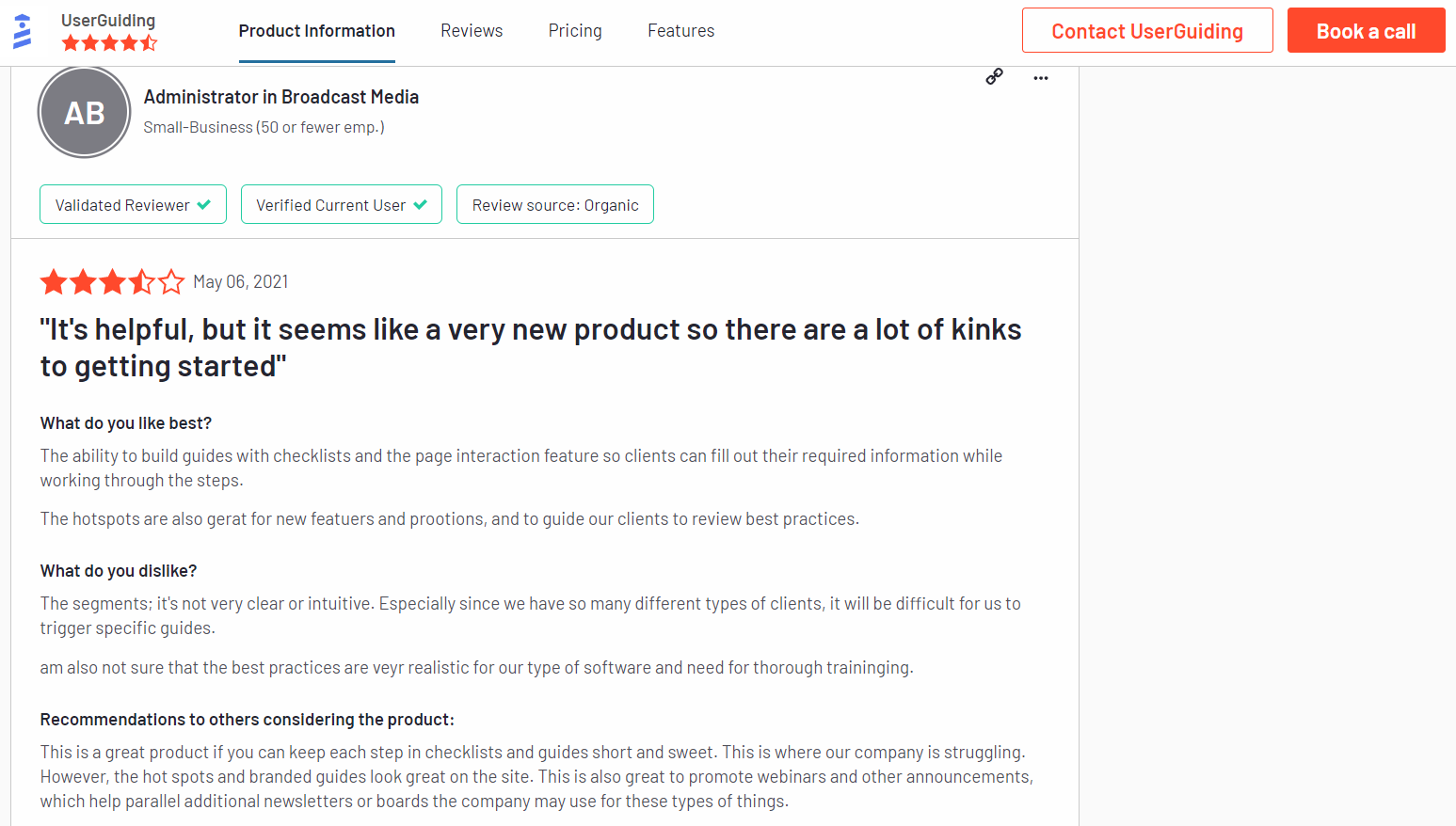
Is Userguiding the right fit for your business?
UserGuiding is a great fit for small SaaS businesses but it might be not the right fit if you want to:
- Create fully interactive product tours.
- Build segments completely code-free as segmentation features aren’t very intuitive and may require additional help from a developer.
- Get in-depth analytics. Though UserGuiding does have analytics functionality, it’s not complex and doesn’t give you much data.
Userguiding pricing
UserGuiding’s pricing model has three tiers, each one charging a set amount for access to certain functionality.
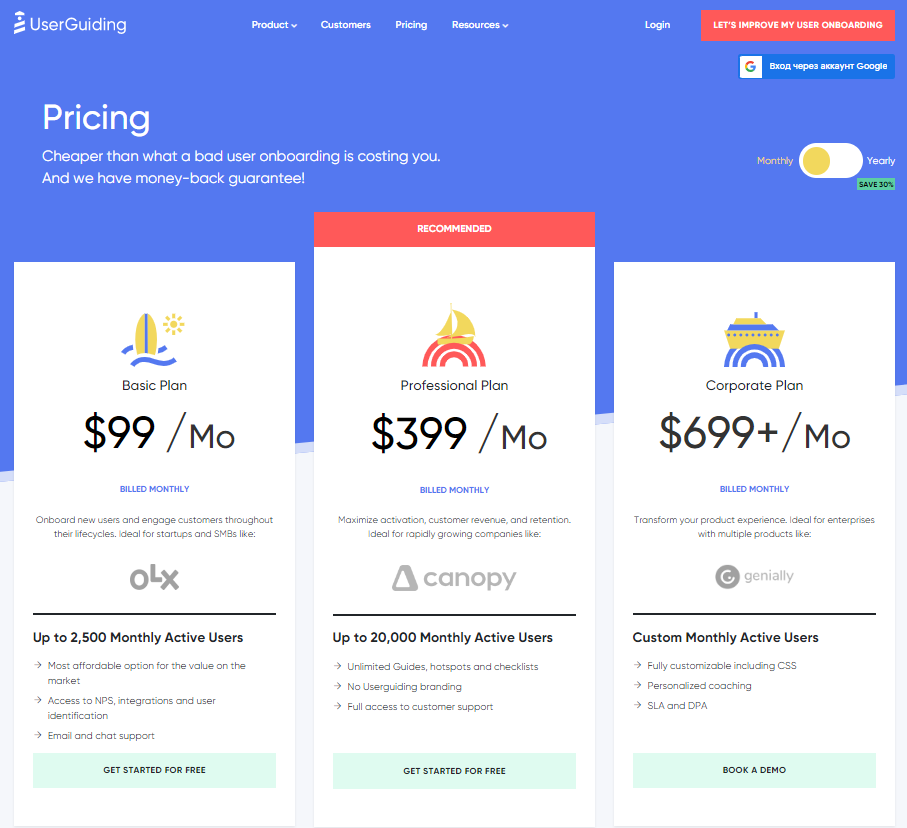
Here are its packages:
- Basic will give you access to only the most essential onboarding tools: Starting at $99/mo or $69/mo (if you buy the yearly contract), this budget option has a few limitations to consider (i.e. just 1 Team Member, a limit of 20 guides, and 2 checklists, UserGuiding branding on all UI patterns).
- Professional adds unlimited guides, hotspots, and checklists. Starting at $399/mo or $299 /mo if billed yearly.
- Corporate gives you access to everything plus personalized coaching. Starting at $699/mo or $499.mo for a yearly plan.
![]()
There is a better tool for your SaaS than Userguiding!

WalkMe for customer feedback
WalkMe is one of the pioneers in the market of adoption tools. It is a cloud-based software that allows you to create product tours and in-app experiences to drive adoption faster.
WalkMe is best for enterprise companies as they are focused on employee onboarding rather than user onboarding.
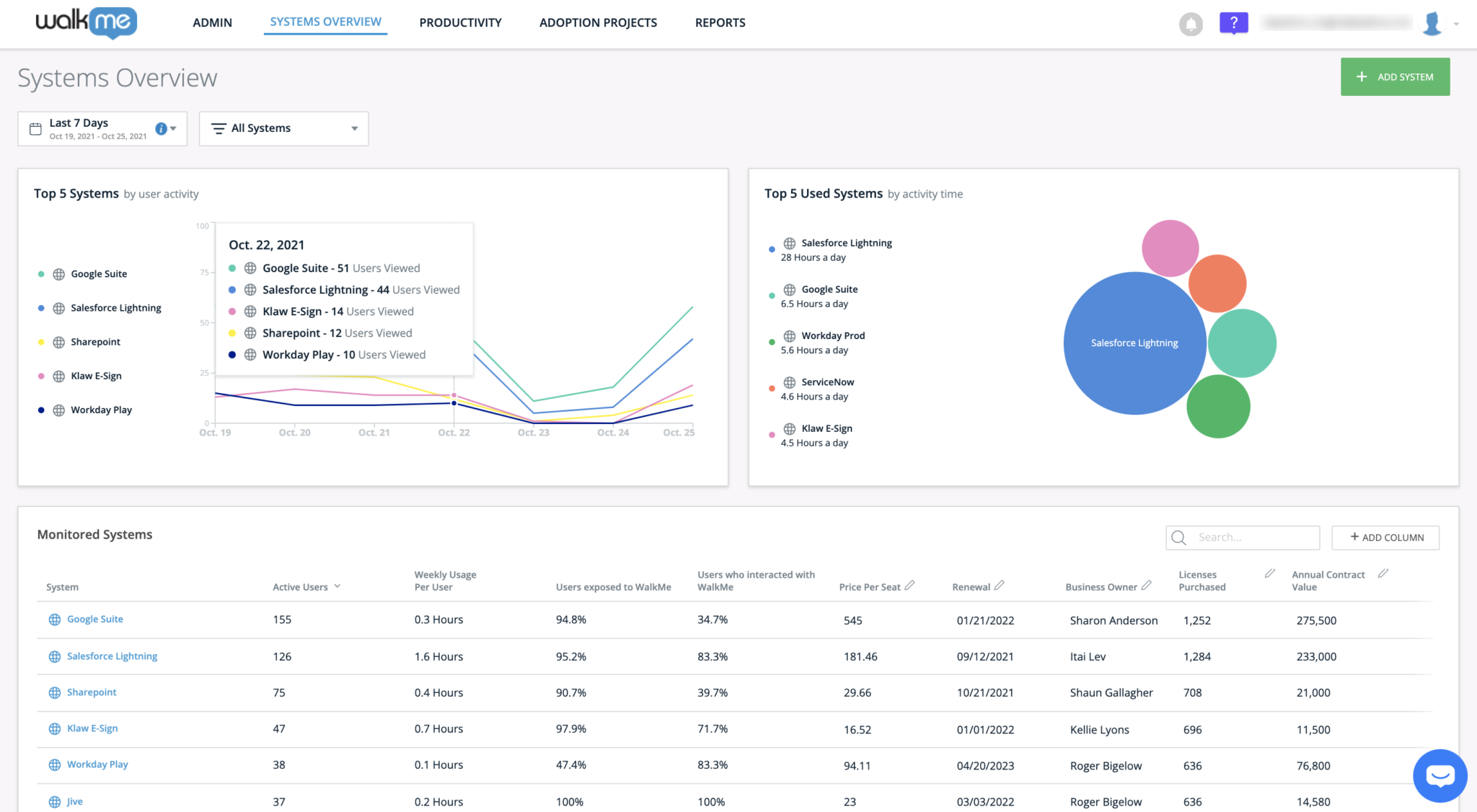
Walkme allows collecting feedback from users so you can make data-driven decisions and improve your product experiences.
Here is what Walkme’s user feedback functionality can offer you:
- Create different types of surveys such as NPS, CSAT, and CES and customize them with different question types such as free text, single selection, multiple selections, and rating to gather feedback from users.
- Implement surveys at any stage of the customer journey to pinpoint areas of improvement and collect ongoing data.
- Analyze the survey results and data in the “Insights” section.
- Customize the design of the surveys with CSS and make sure they are aligned with your brand colors and style.
- Set frequency rates and decide how often and when the surveys should appear to end users.
Pros of Walkme
WalkMe has its fair share of advantages that make it a solid tool. So what are WalkMe’s pros?
Here are our top three:
- Offers a high level of customization and works on both your own tool and 3rd party tools.
- Allows you to create in-app quizzes to test user or employee knowledge after completing a flow.
- Get access to a vast list of integrations that simply enhance your data collection or allow you to connect multiple tools in your stack.
Cons of Walkme
WalkMe is an established tool on the market but it does have its own share of cons too.
Here are the main ones you should consider when looking at alternatives:
- There’s a steep learning curve and a fair amount of technical knowledge required to create WalkMe user guides and get them implemented the way they’re intended.
- WalkMe is designed for enterprise organizations, and its pricing reflects that.
- You could end up spending anything from $9000 to $50000 a year on WalkMe. That’s a lot of money for startups and SMEs.
What users say about Walkme?
Users are mostly happy with WalkMe’s features: on-screen guidance, interactive walkthroughs, customizable UI patterns, and journey segmentation are highly used and appreciated by customers.
Here are some reviews from real users.
“The most valuable thing WalkMe provides is time. WalkMe provides the user with on-screen guidance to get them to where they need to be without weighing down support teams on training for every function. The automated steps can remove multiple clicks and quickly send the user to what they need to see. The ability to view user activity and search terms allows mapping new build requirements properly.”
“WalkMe is very user-friendly and easy to learn! There are so many different features of WalkMe to provide a customizable and creative experience for all of our users. I love creating smart walkthroughs and building flows charts, which is the most fun part of my day-to-day tasks!”
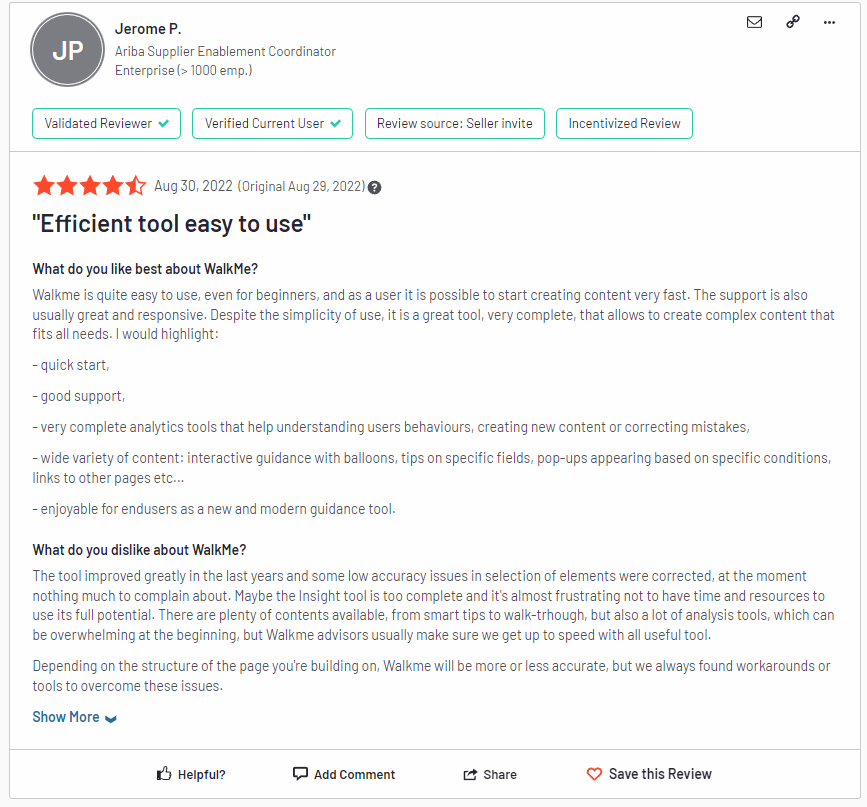
But Walkme is not a perfect solution, most complaints are about hard implementation and annual contract pricing.
Here are some words from real Walkme users:
We never had time to implement the product. It takes a huge time investment and isn’t designed for the full documentation. Rather than maintain two sets of documentation, we removed Walkme from our product. This company is as bad as AOL or TimeWarner: they will not let you out of your multi-year contract no matter how unhappy you are with the product.
The tool is not very intuitive and has countless challenges using and technical difficulties.
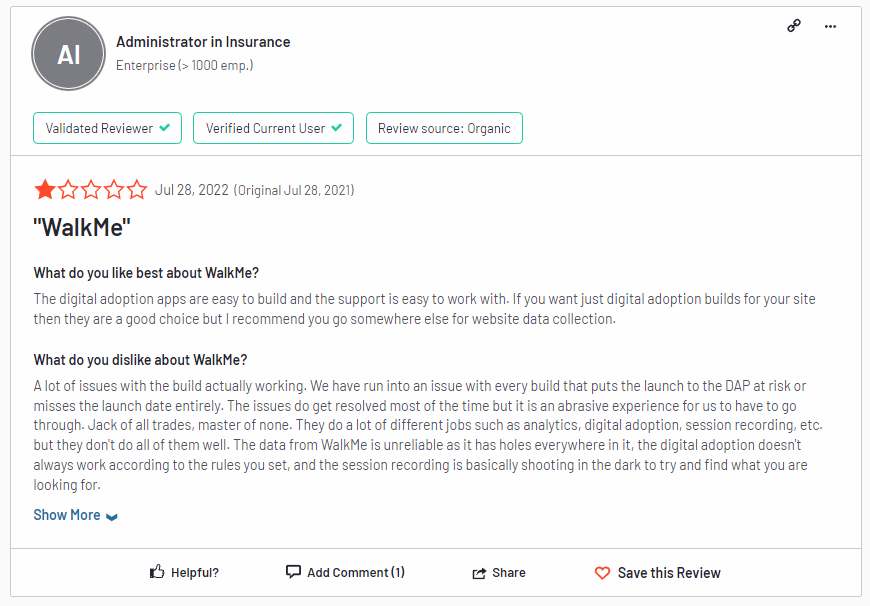
Is Walkme the right fit for your business?
Is WalkMe all you need or are there better alternatives that can provide more value at a much lower price? Here are the main reasons you should look for an alternative:
- WalkMe offers only yearly pricing contracts which start at $9000 so if you want to onboard new customers or provide in-app guidance then there are better solutions that won’t lock you in.
- WalkMe is known for its hard implementation so it’s not recommended for non-technical people. Generally, it can take weeks or even months. For better comparison, Userpilot can be set up in just a few minutes as it’s completely code-free.
- Bad and outdated UX design is another thing that might disappoint you and make you search for alternatives.
WalkMe pricing
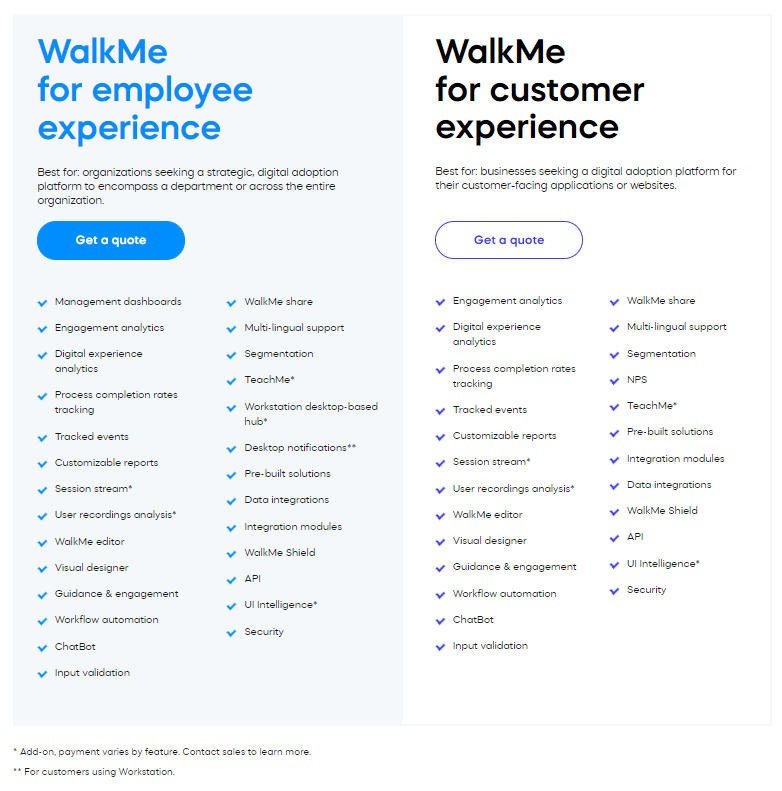
WalkMe works on a custom pricing plan that requires you to request a quote from their sales team (could be spending from $9000 to $50000 a year).
Their main two plans are:
- WalkMe for employee onboarding experience: engagement tools and analytics
- WalkMe for customer experience: engagement tools and analytics
- Add-ons: Session Streams, TeachMe, AI analytics through UI intelligence
![]()
There is a better tool for your SaaS than Walkme!

Is there a better alternative for customer feedback?
Userguiding and Walkme are good tools for customer feedback. We’ve seen how they compare to each other and what you can achieve with them. Call us biased, but if you’re looking for something better, Userpilot offers more value for your money than these tools.
Userpilot for customer feedback
Userpilot is a powerful product adoption platform that enables you to quickly build personalized, flexible, contextually relevant in-app experiences targeted to different user segments – all without writing a line of code.

There are two types of feedback you should be focusing on collecting to better understand the health of your product and users.
First, you have user sentiment which looks at user satisfaction and effort scores or loyalty (using NPS surveys). Then you may also want to collect feedback on the functionality of the product or specific features.
You can do all these with Userpilot. In short, you can:
- Collect and track (NPS) in-app with a built-in NPS widget that allows you to fully customize the survey look and feel, and set the trigger frequency and specific targeting.
- Analyze NPS scores, tag responses, and use the data to create specific user segments.
- Build and trigger in-app micro surveys like the classic PMF survey, or similar ones and mix multi-choice and open-ended types of questions to collect specific insights.
- Be in charge of who gets which survey type and when with advanced segmentation capabilities, and of course, you can use the answers to segment your audience.
The advantage of using Userpilot for collecting feedback over other survey tools is that you can better control who sees the surveys but also you can instantly use the data collected to segment your user base and trigger the right experience for them.
For instance, if your users give you a low NPS score because they think you’re missing a critical feature (that you actually have already), you can push an interactive walkthrough guiding them to find and explore this feature.
Pros of Userpilot
Userpilot has a number of advantages, especially for mid-market SaaS companies looking for a robust but at the same time very easy-to-use, no-code tool for user onboarding, product adoption, and simplified product analytics. Let’s have a look at the pros of using Userpilot:
- No-code builder – Userpilot comes with an easy-to-use Chrome Extension builder.
- Multiple UI patterns – choose from a range of options to build customized flows: modals, slideouts, banners, tooltips, hotspots, and checklists are all at your disposal
- UI patterns are not limited by plan – you get access to all of them on every single plan, meaning you get value even with the Traction plan (this is the entry-level one).
- Engaging walkthroughs and onboarding flows- build interactive walkthroughs targeted to distinct user segments.
- In-app help – build a resource center offering self-service support to your users, customize it with your branding, and select from a range of help options to boost user satisfaction (i.e. videos, in-app flows, chat, and more).
- Experimentation – built-in A/B testing for flows lets you explore and quickly iterate based on direct user behavior.
- Powerful feedback options- integrated NPS surveys with analytics and response tagging unlock insight into how your users feel.
- Advanced analytics and segmentation- analyze product usage and in-app flow engagement and build user segments using the data.
- Event tracking and feature tags- tag UI engagement (clicks, form fills, hovers) and group them into one custom event to track what really matters.
- More value with integrations- unlock value faster with built-in integrations with popular tools like Segment, Amplitude, Mixpanel, Kissmetrics, Intercom, Heap, and more.
Cons of Userpilot
There are, however, some downsides to Userpilot as well:
- Browser/web app only – Userpilot won’t run on mobile devices/applications.
- Doesn’t support employee onboarding- The tool is better suited for customer onboarding than for employee onboarding as you can’t build in-app guides on third-party tools.
- Missing integrations – doesn’t have built-in integrations with some tools, but it has webhooks, and Hubspot and Zapier are coming soon.
- Not appropriate for small startups on a shoestring budget (<$100)- Userpilot is a powerful, mid-market to enterprise-level tool. So $249 a month might be too expensive for really small startups.
What users say about Userpilot

Let’s check what real users like about Userpilot.
Userpilot is an incredible, user-friendly software that allows us to create unforgettable experiences for our clients! From basic to complex experiences, we have been able to do them all with ease! I would highly recommend this software to anyone who wants to provide their clients or users with the best product tour experience. The possibilities of what you can create are endless! – Tayla G.
Userpilot is simple to set up, use, and does not require any dev – which means instant publishing. This is critical for us as a SaaS company that releases new features frequently; we need the ability to inform our customers of changes quickly, and doing this in our platform through Userpilot allows us to reach the right audience, at the right time, in the right place. There have been many awesome extra features we’ve discovered since coming on board, and it’s been great to see new features released frequently. The tool itself is intuitive and reliable. Having used similar products previously that were clunky and buggy this has really made us happy with our decision to move to Userpilot. – Melina K.
![]()
Get more value for your money with Userpilot!

Userpilot pricing
Userpilot offers great value for money compared to other similar tools on the market. Even its entry-level plan (Traction) provides all the necessary features without any usage limit.
Here’s the detailed Userpilot pricing:
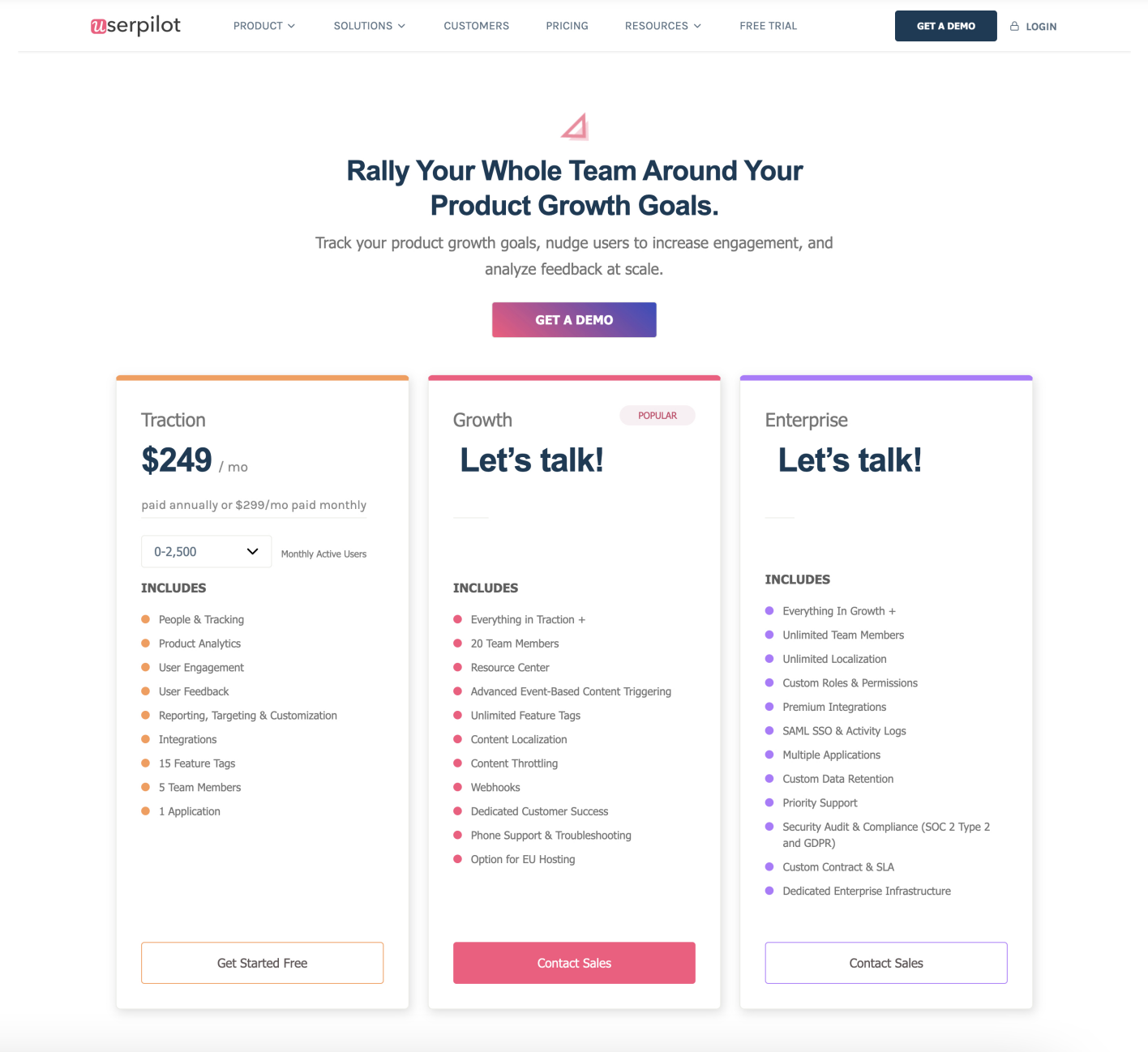
Conclusion
There you have it.
It should be easier now to make an informed decision between Userguiding and Walkme. Both tools come with advantages and disadvantages so there isn’t one that is the best. It will depend on your product and current needs. If you want the best value for money, going with the alternative option would be our recommendation. Want to see how Userpilot can help with customer feedback? Book a demo below.
![]()
There is a better tool for your SaaS than Userguiding!


